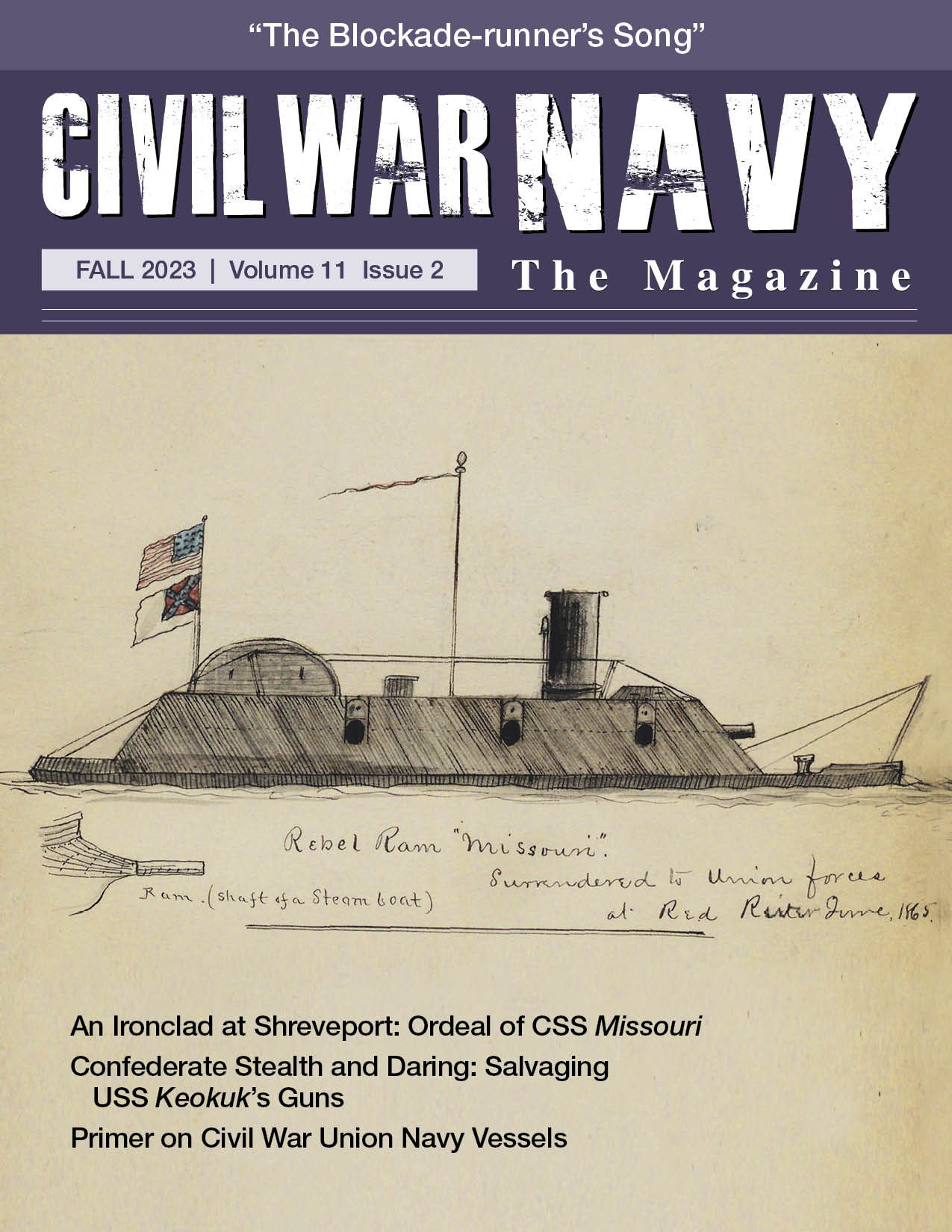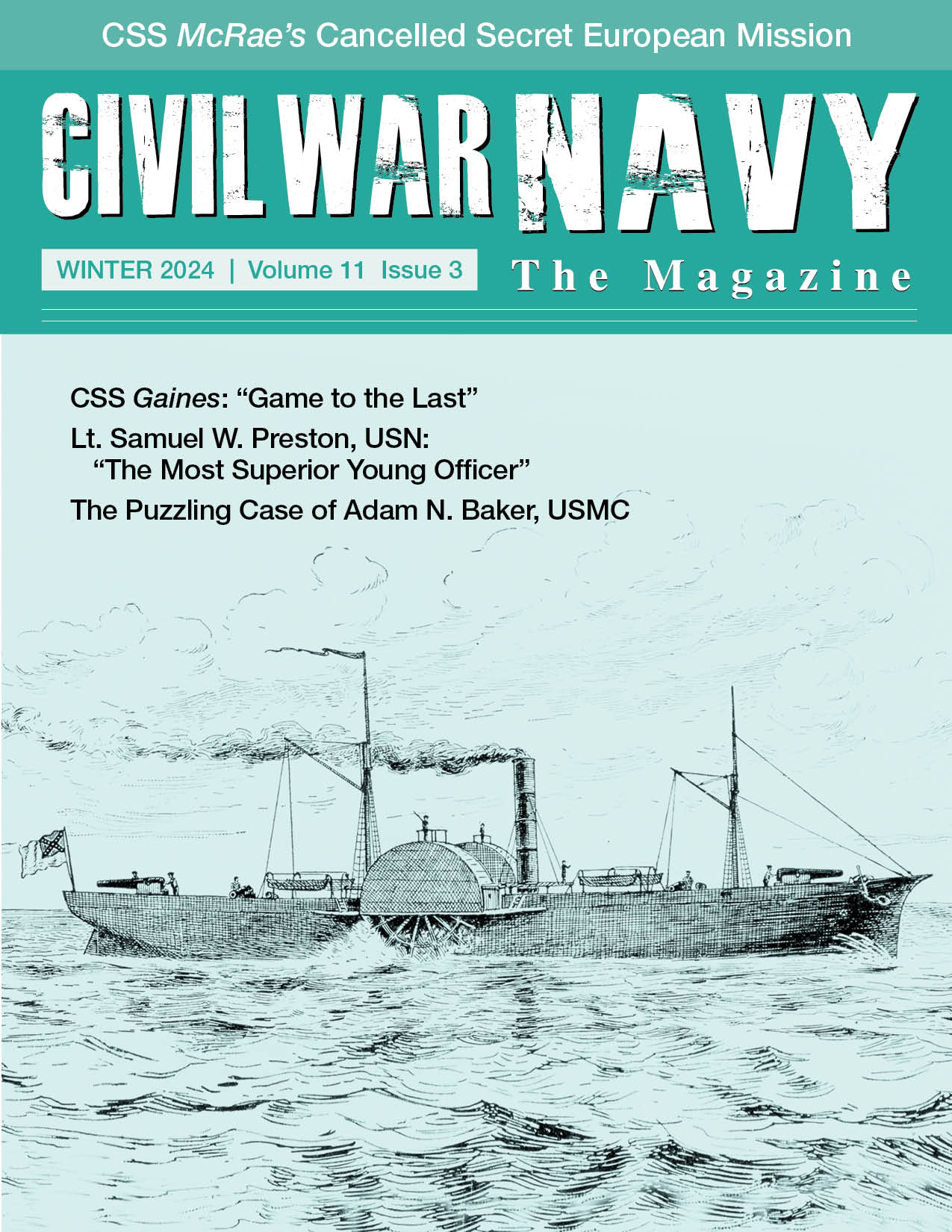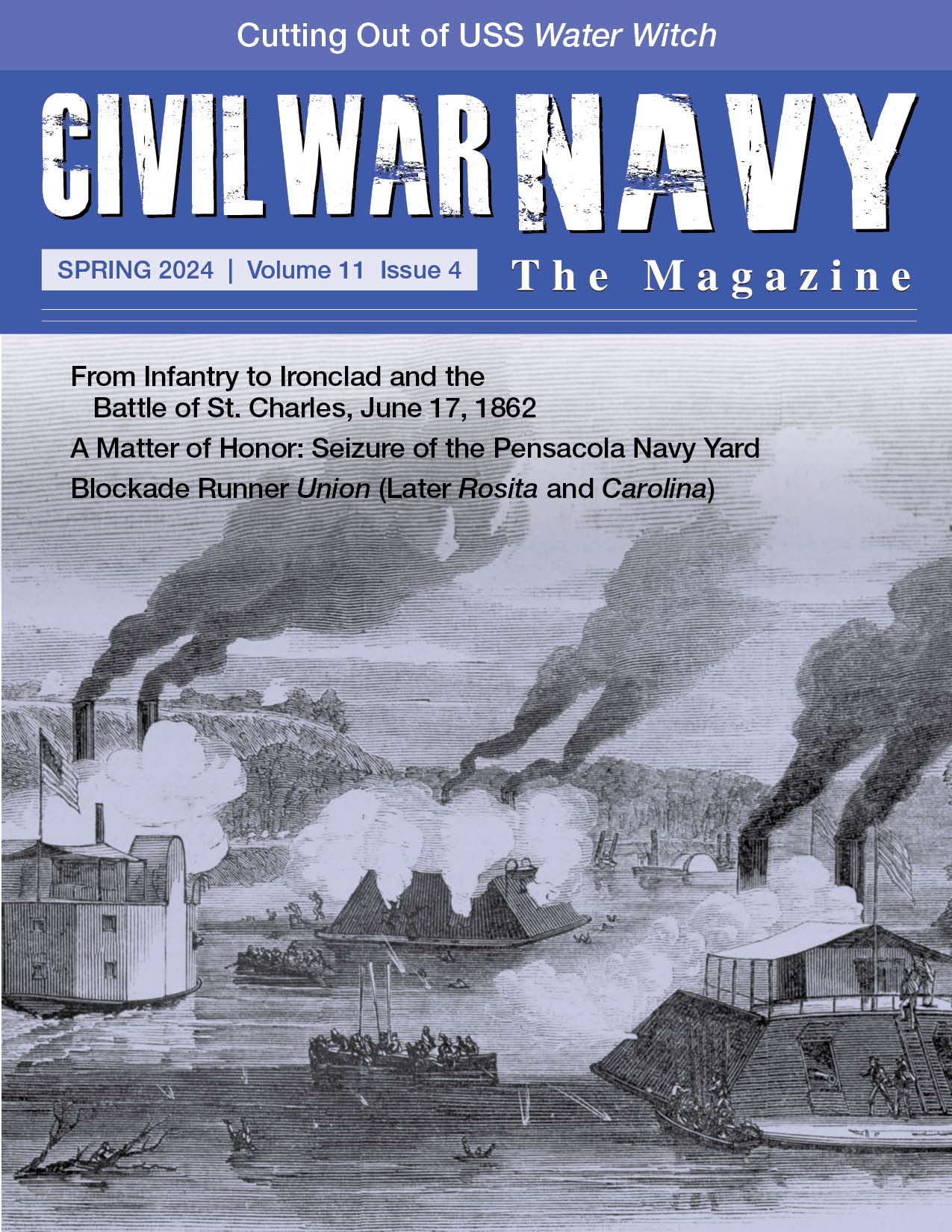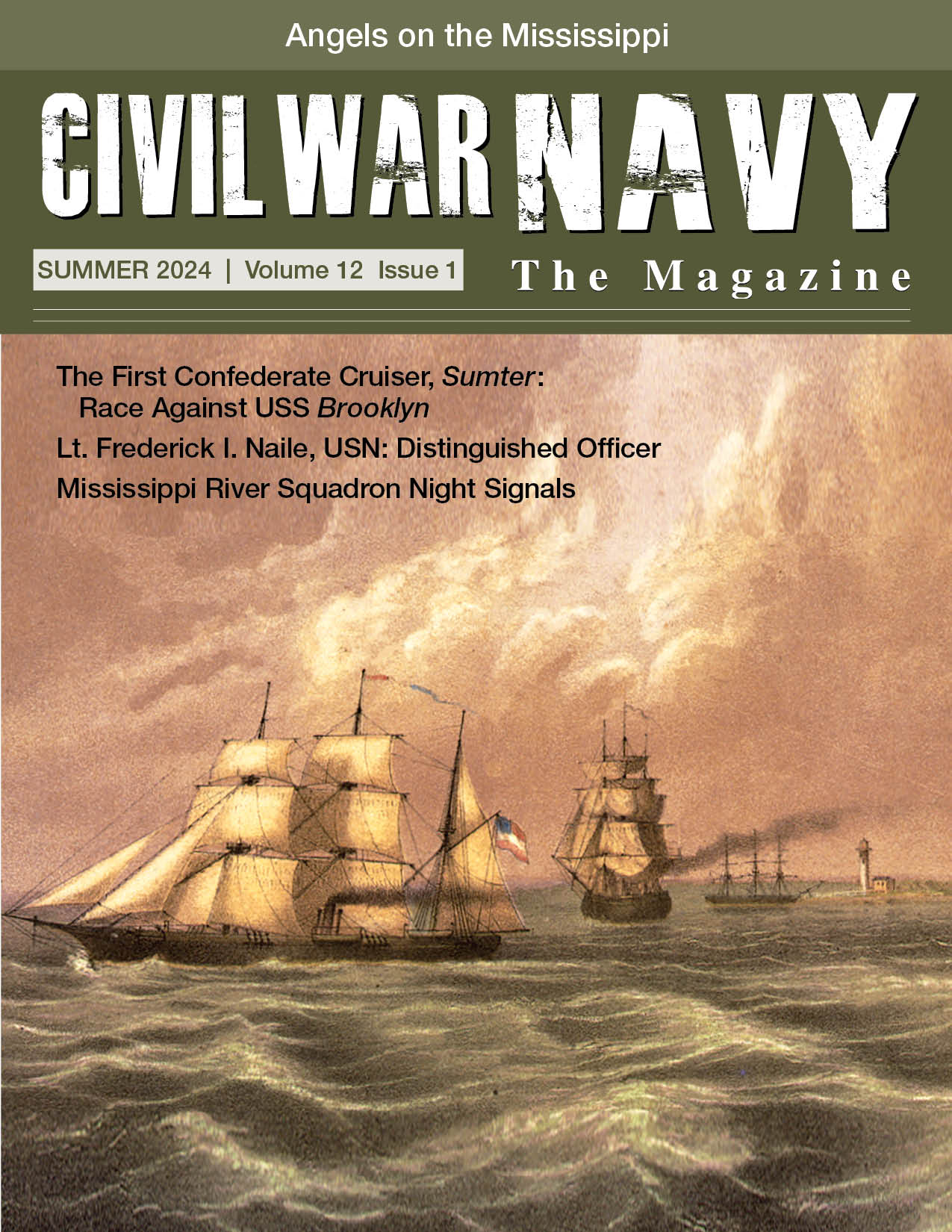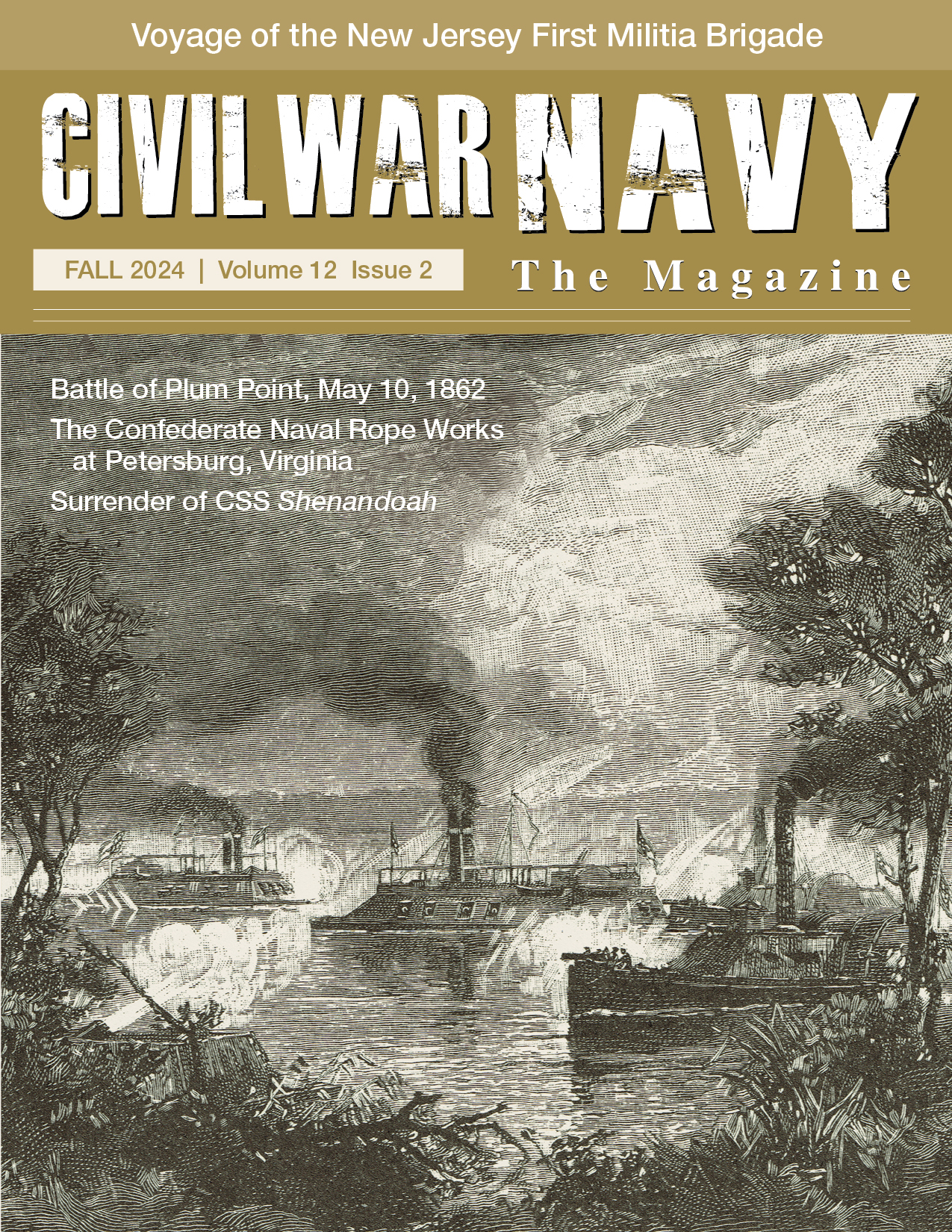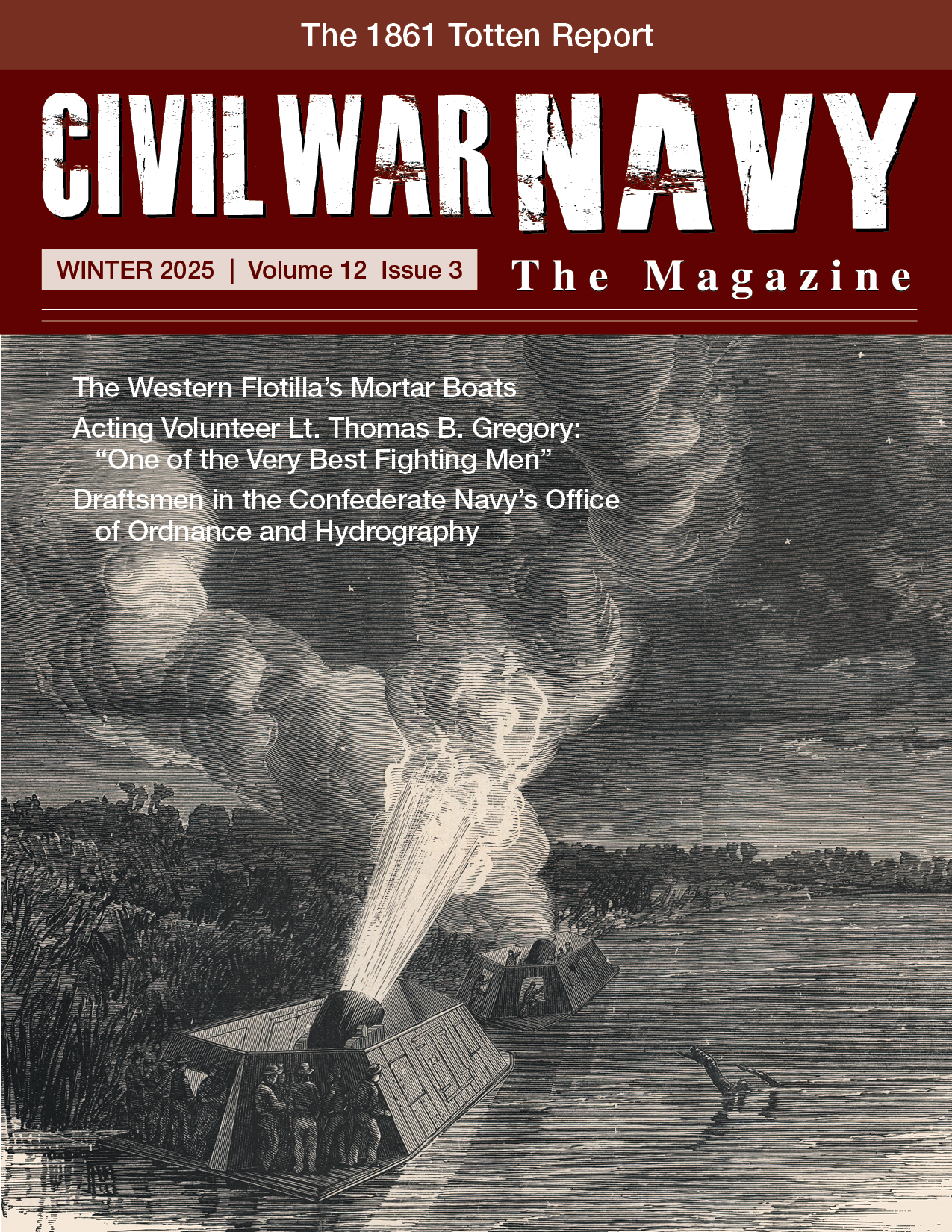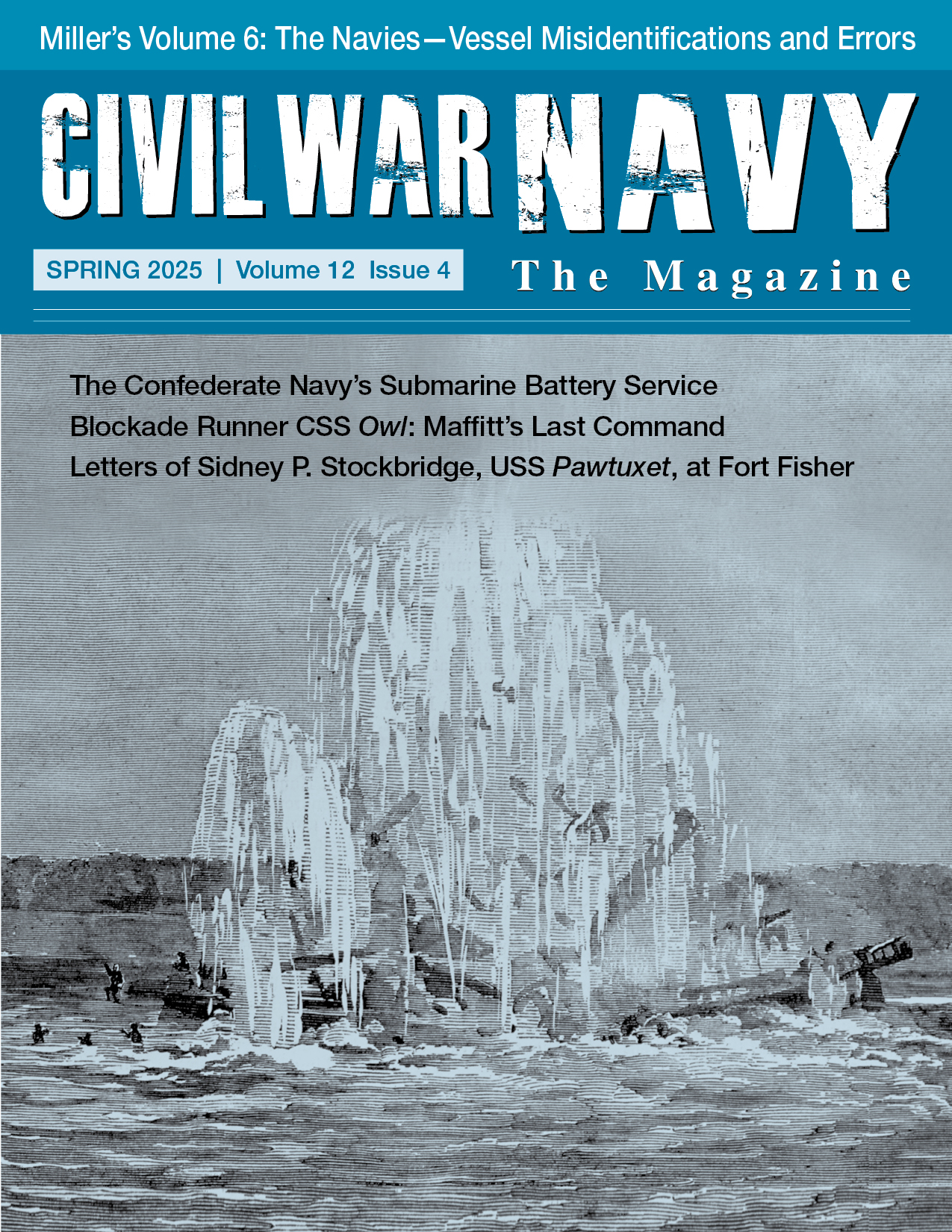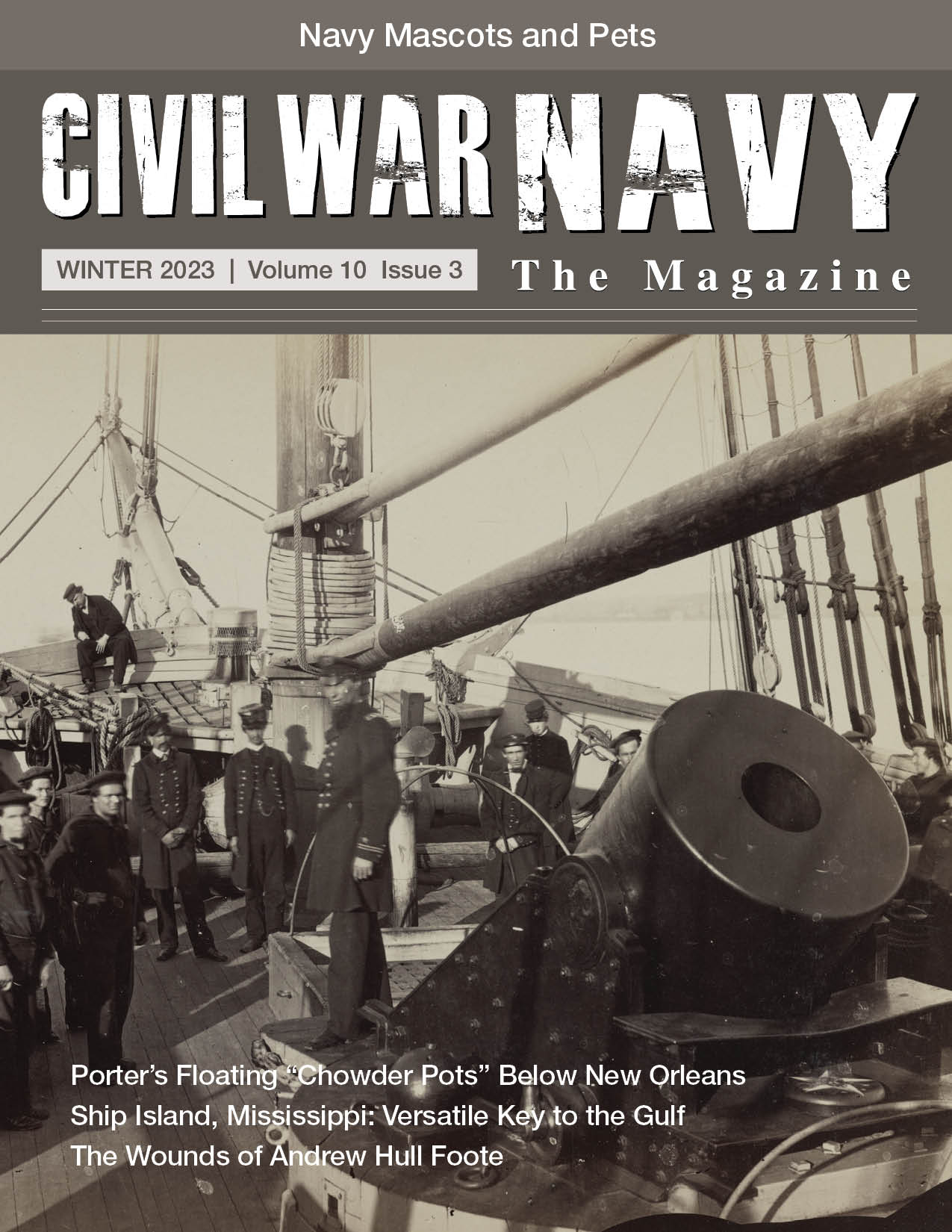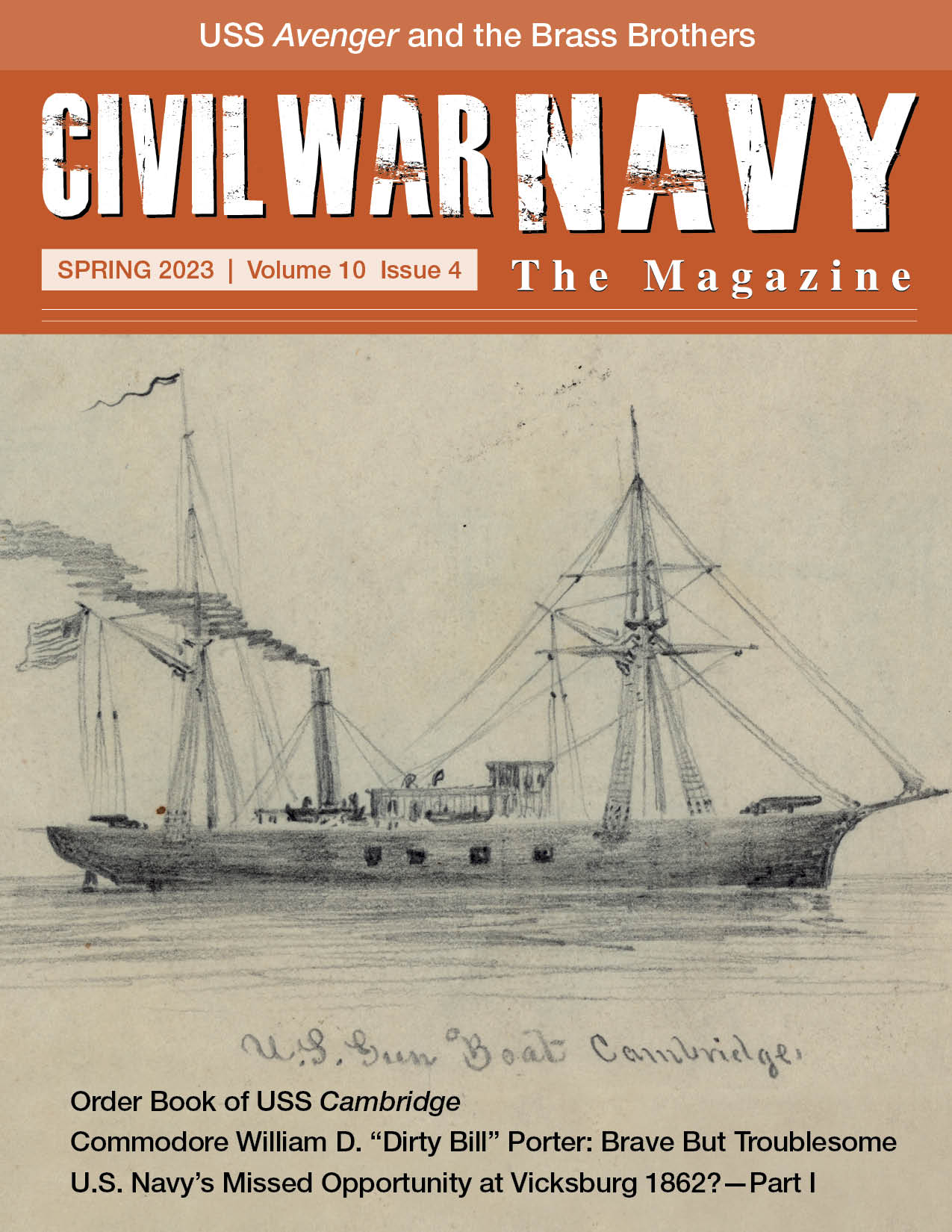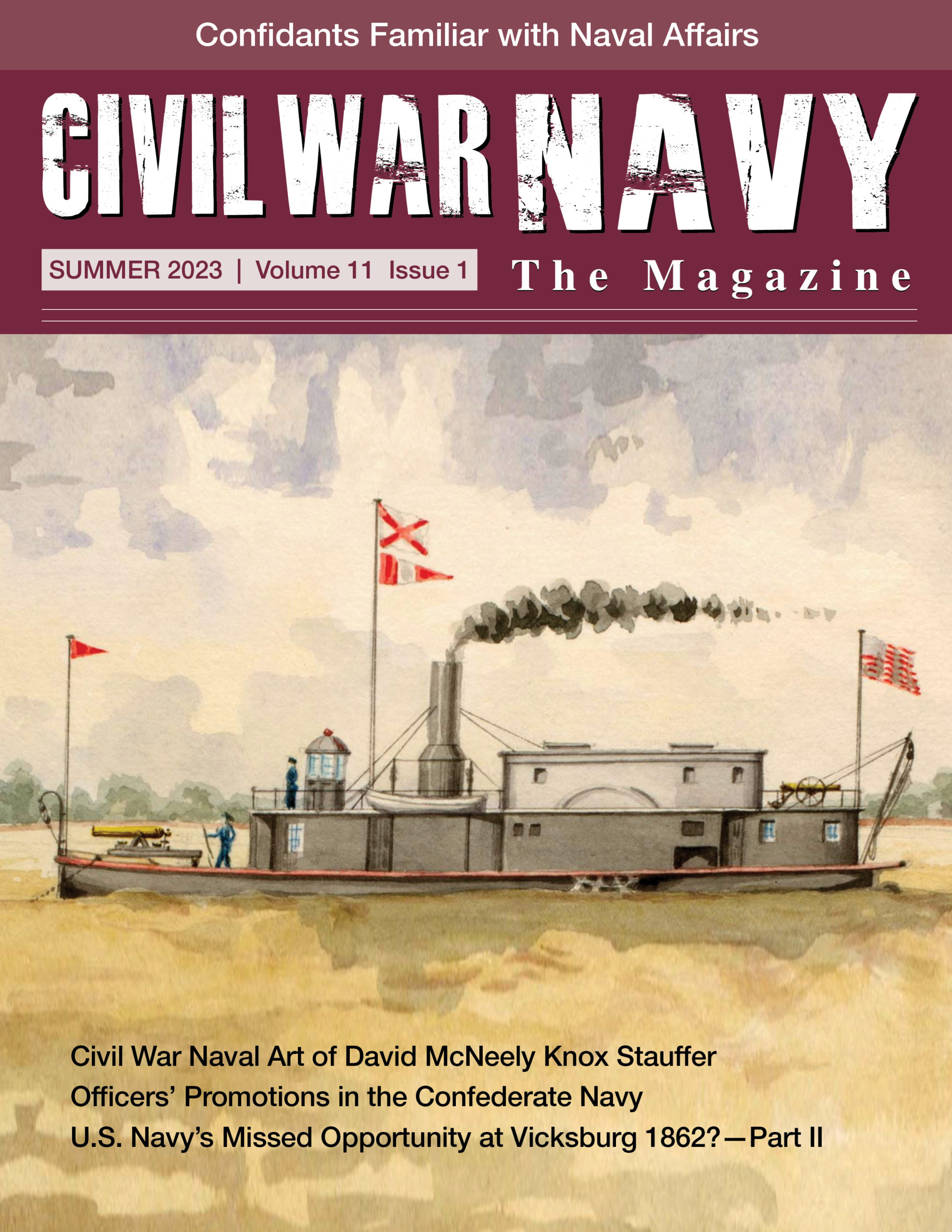Confederate Shipyards
By
Gary McQuarrie, Managing Editor
Neil P. Chatelain
OVERVIEW
When the Civil War started, the Confederate states did not have the facilities needed to construct or equip warships.1 The first centers of shipbuilding in the Confederacy were coastal cities that were also significant shipping ports–Norfolk, Charleston, Savannah, Mobile, and New Orleans. Eventually, shipbuilding facilities of various sizes and abilities were spread across many locations on the coasts and rivers of the South. When the Confederate States Navy was organized, it did not include a specific bureau to oversee construction, so shipbuilding efforts were widespread and poorly coordinated.1-3
The Confederacy lacked the industrial base of the North and so shipbuilding was undertaken on a much smaller scale. The South’s shipbuilding efforts were chronically plagued with shortages of material, machinery, and labor. The overall Confederate strategy of defense also determined the naval policy—the Confederate Navy’s efforts concentrated on defending key ports, inlets, bays, and rivers, while cruisers attacked and destroyed Union shipping to divert resources away from the Union’s blockading effort. With the South lacking facilities to build large warships, Matthew Fontaine Maury proposed building small wooden gunboats (‘Maury gunboats’) for river and harbor defense. Secretary of the Navy Stephen R. Mallory was convinced that the South could never match the North in terms of numbers of warships, but that this inequality could be compensated by building ironclads. The Confederacy managed to complete to the point of naming, 34 ironclads, 25 of which were commissioned.4 Except for the very small CSS Manassas in 1862 and the CSS Albemarle in 1864, no Confederate ironclad was sunk or destroyed by Union vessels—most were scuttled or burned to prevent capture. Despite his focus on ironclads, Mallory did develop a plan for a fleet of small wooden gunboats—at least five such vessels were contracted but never completed. Mallory also approved the building of larger wooden-hull gunboats as the war began. Thus, shipbuilding proceeded on multiple avenues but focused on ironclads.1-4
The losses of New Orleans, Memphis, Norfolk, Jacksonville, New Bern, and Pensacola in 1862 were disastrous for the shipbuilding program. In addition to losing vessels under construction, stores and equipment were lost, forcing the building efforts inland where possible—typically safer small river towns or even plots of land adjacent to rivers or inlets where a makeshift yard could be set up and a vessel built and launched without the threat of encroaching Union forces—their exact number is not known because of frequent abandonment or new construction. During the war, the Confederacy converted, contracted for, or laid down at least 150 warships—approximately one-third were steamers converted to gunboats, one-third were wooden gunboats, and one-third were ironclads.1 Numerous armored and wooden vessels were built from the keel up and completed—the remainder (a majority) were either not completed for insufficient supplies of labor, materials, and facilities, or destroyed as a result of having to withdraw from the areas of building for military reasons or to prevent capture.5
The summary is intended to be a comprehensive, but not necessarily a complete list of all shipbuilding facilities, yards, and locations in the South during the war. Vessels constructed in England are not included. A separate list of the principal Confederate Naval Yards and Stations is available under Resources.
References
1. William N. Still, Jr. Confederate Shipbuilding (Athens, GA: University of Georgia Press, 1996).
2. William N. Still, Jr. Facilities for the Construction of War Vessels in the Confederacy. The Journal of Southern History, Volume XXXI, No. 3, August 1965, p 285-304.
3. William N. Still, Jr., Editor. The Confederate Navy: The Ships, Men and Organization, 1861-65 (London: Conway Maritime Press, 1997).
4.Thomas Campbell. Confederate Ironclads at War (Jefferson, NC: McFarland & Company, Inc., Publishers, 2019).
5. Paul H. Silverstone. Civil War Navies 1855-1883 (Annapolis, MD: Naval Institute Press, 2001), p 147-205.
VIRGINIA
Fredericksburg
A short-lived facility near the City Dock on the Rappahannock River was apparently the site of construction of wooden gunboats that were never completed before Union forces advanced on the city in April 1862.
Gosport
This U.S. Navy Yard was captured by the Confederates on April 20, 1861 and held until May 1862. During this time, the casemate ironclad CSS Virginia was constructed using the burned-out hull of USS Merrimack. CSS Richmond was constructed and launched from Gosport to be completed at Richmond. Five ‘Maury gunboats’ (Norfolk, Portsmouth, Escambia, Elizabeth, Yadkin) were laid down at this site in 1861 and 1862 but never completed. Similar to ‘Maury gunboats’ but with sail rigs, Dixie and several unnamed gunboats were laid down in 1862 but never finished.
Additional Information
John V. Quarstein. The Capture of Gosport Navy Yard. Civil War Navy—The Magazine, Volume 5, No. 4, Spring 2018, p 13-23.
Alan B. Flanders. The Night They Burned the Yard. Civil War Times Illustrated, Volume XVIII, No. 10, February 1980, p 30-39.
Richmond
The ironclad CSS Richmond was completed at Rocketts shipyard in Richmond. The ironclad CSS Fredericksburg was also built at Rocketts. Two gunboats, CSS Hampton and CSS Nansemond, were built at Richmond. Across the James River from Rocketts, adjacent to the city of Manchester, a second shipyard was established by spring 1862 and the ironclad Virginia II and several spar torpedo boats (Hornet, Scorpion, Squib, Wasp) were constructed and launched at this site, but only Squib was commissioned. The torpedo boat tender, Torpedo, was also built and commissioned here in 1863.
Additional Information
John M. Coski. Capital Navy (New York, NY: Savas Beatie, LLC, 1996).
NORTH CAROLINA
Charlotte
When the evacuation of Gosport Navy Yard was anticipated, Charlotte was chosen as a safer interior shipbuilding location because of rail connections to seaports. Machinery and a small steam hammer were shipped quickly to the site from Gosport. On the property itself, large-frame structures were erected to house shops (e.g., gun-carriage construction, a large forge shop), a foundry, coke ovens, and stores; a hoisting crane was also erected. The property was bounded by the tracks of the North Carolina Central Railroad and the tracks of the South Carolina Railroad. Many of the mechanics employed had come from Gosport.
Additional Information
Violet G. Alexander. The Confederate States Naval Yard at Charlotte, N.C. 1862-1865. Southern Historical Society Papers, Volume XL (New Series, No. II), September 1915, p 183-194.
Ralph W. Donnelly. The Charlotte, North Carolina, Navy Yard, C.S.N. Civil War History, Volume 5, No. 1, March 1959, p 72-79.
Edwards Ferry
CSS Albemarle, a casemate ironclad ram ‘Beast,” was constructed by Gilbert Elliott in a sloping cornfield owned by William Ruffin Smith, Jr. on the south bank of the Roanoke River near a river crossing known as Edwards Ferry. Elliott assigned Smith’s son, Peter Evan Smith as superintendent of construction. A steam saw mill was set up and the plantation had an elaborate forge and labor was plentiful. The location allowed protection from the rising river, but was close enough to the river to allow launching. Albemarle was launched on October 6, 1863, and towed upriver 22 miles to Halifax to be armored and fitted out with machinery. She was commissioned on April 17, 1864. A wooden, steam-powered screw gunboat Fisher was laid down at the site in 1865 but never completed.
Halifax
Converted from a towboat at this site, the gunboat Halifax was launched in 1865 but never commissioned and was captured by Union forces on the ways in May 1865.
Tarboro
An unnamed ironclad was contracted to W.F. Martin and Gilbert Elliott in September 1862 and began construction across the Tar River from Tarboro—work continued intermittently until the unfinished vessel was burned by Union forces in July 1863.
Whitehall
CSS Neuse was constructed at Whitehall (currently Seven Springs) by Howard (Thomas S.) & Ellis (Elijah W.) Shipbuilders of New Bern; following evacuation from New Bern, they secured a contract to construct Neuse and chose a sloping area of ground on the north side of the Neuse River across from Whitehall as the construction site.
Wilmington
A number of Confederate vessels, including the casemate ironclad CSS North Carolina (commissioned in December 1863), were built in Benjamin Washington Beery and William L. Beery’s shipyard across the Cape Fear River on Eagles Island. An ironclad with two short casemates, each holding one pivot gun, CSS Wilmington, was laid down in Beery’s shipyard in 1863 but never completed; it was destroyed on the stocks in January 1865. Yadkin, which may have begun as a ‘Maury gunboat,’ was converted at Beery’s and commissioned in 1864. Beery’s also constructed two torpedo boats. James L. Cassidey’s shipyard and outfitting station completed the ironclad steam sloop CSS Raleigh in 1864. Arctic, a lightship, was converted to an ironclad floating battery in 1863; its machinery had been removed in late 1862 for CSS Richmond. A torpedo boat was also constructed, but was destroyed when a fire swept through the yard in April 1864.
Additional Information
Edwin L. Coombs III. Confederate Shipbuilding on the Cape Fear River, The North Carolina Historical Review, Volume 73, No. 4, October 1996, p 409-434.
SOUTH CAROLINA
Charleston
CSS Palmetto State (built by Cameron and Company), CSS Chicora (built by James M. Eason), CSS Columbia (built by Jones & Eason) and CSS Charleston (built by James M. Eason) were constructed here, the latter serving as the flagship of the Charleston Squadron. The spar torpedo boat CSS Torch was built here by F.M. Jones in 1863—it may have begun as a ‘Maury gunboat.’ It lacked armor, and its machinery was unreliable. Torch served in the defense of the city and did make an unsuccessful attack on USS New Ironsides in August 1863. The cigar-shaped spar torpedo boat CSS David was designed by Captain Francis D. Lee and built at Dr. St. Julien Ravenel’s plantation approximately 30 miles up the Cooper River from Charleston, overseen by David C. Ebaugh who was superintendent of a niter works on the plantation—after completion, she was sent to Charleston to have machinery installed and launching off of a wharf. Two other David-type torpedo boats were constructed at Charleston but not completed. The spar torpedo boat, Midge, was built in Charleston and commissioned in 1864. General Clinch, a sidewheel steamer with 2 guns was built by J. Poyas in the city.
Additional Information
Thomas Campbell. A Torpedo Boat Named David, Civil War Navy—The Magazine, Volume 7, Issue 3, Winter 2020, p 34-45.
Ron Field. Charleston Naval Station, 1861-1865, Civil War Navy—The Magazine, Volume 8, Issue 1, Summer 2020, p 50-57.
Mars Bluff
Located near Marion Courthouse and on the east side of Great Pee Dee River, Mars Bluff was an interior shipbuilding location close to a major waterway and a railroad connection, with an abundance of wood preferred for constructing gunboats. Construction of Pee Dee, a twin-screw, steamer gunboat armed with three guns, was approved in the fall of 1861 but was not commissioned until April 1864—she was destroyed in the Pee Dee River near Georgetown, South Carolina, to prevent capture in February 1865 on the evacuation of Charleston, having never fired a shot.
GEORGIA
Columbus
Situated on the Chattahoochee River, Columbus had a shipyard formed near the Confederate Navy’s iron works in Columbus. The iron works provided machinery to many Confederate warships, and the shipyard completed the ironclad CSS Jackson (originally Muscogee) in late 1864. The spar torpedo boat Viper was built at the site and launched on March 31, 1865, but not completed. Union forces assaulted Columbus on April 16, 1865, capturing the shipyard, and the ironclad CSS Jackson, which were burned the next day.
Additional Information
Raimondo Luraghi. A History of the Confederate Navy, Translated by Paolo E. Coletta. (Annapolis, MD, Naval Institute Press, 1996), p 45, 282, 289.
William N. Still, Jr. Confederate Shipbuilding (Athens, GA: University of Georgia Press, 1969), p 38-39.
Saffold
At a shipbuilding yard operated by David S. Johnston, the wooden-hulled, twin-screw steamer gunboat CSS Chattachoochee, armed with six guns, was approved for construction in the fall of 1861—it was built under the supervision of Lieutenant Catesby ap R. Jones and commissioned in January 1863. In late May, a boiler explosion sunk her at Blountstown, Florida—she was raised and repaired at Columbus, Georgia, only to be destroyed to prevent her capture in the Apalachicola River, Florida, in December 1864.
Savannah
The civilian shipyard of Henry F. Willink oversaw construction of several wooden gunboats and the ironclad CSS Savannah and the ironclad floating battery CSS Georgia. The iron-hulled blockade runner Fingal (built in Glasgow, Scotland) was converted to the casemate ironclad CSS Atlanta in Savannah. The casemate ironclad Milledgeville was laid down in 1863 and launched in 1864, but never finished. Willink also converted the former Ogeechee into the gunboat Macon, commissioned in August 1864. The side-wheel gunboat Sampson was converted from a tugboat and commissioned in 1861. The wooden gunboat, Isondiga (probably started as a ‘Maury gunboat’), armed with two guns, was built by Krenson & Hawkes, and commissioned in April 1863. The shipyard facilities and remaining vessels were destroyed in December 1864 as General William T. Sherman’s Union forces approached.
Additional Information
Raimondo Luraghi. A History of the Confederate Navy, Translated by Paolo E. Coletta. (Annapolis, MD: Naval Institute Press, 1996), p 30, 332.
Maurice Melton. The Best Station of Them All: The Savannah Squadron 1861-1865 (Tuscaloosa, AL: University of Alabama Press, 2012), p 66, 151, 206, 388-389.
FLORIDA
Warrington Navy Yard, Pensacola
Having been captured by the Confederates in January 1861, this site received approval to construct a large wooden-hulled ship in the fall of 1861. When the yard fell into Confederate hands, the side-wheel sloop Fulton was captured; it was nearly repaired when the Confederates destroyed it when Union forces reoccupied it.
ALABAMA
Mobile
Civilian shipyards in Mobile constructed the wooden gunboats CSS Gaines (partially iron-armored, double side-wheel built by Bassett & Gates and commissioned in February 1862; first vessel built from keel up in the Confederacy) and CSS Morgan (also built by Bassett & Gates, completed in 1862) and helped complete ironclads whose hulls were fabricated at Selma or Montgomery, Alabama, most notably the ironclad CSS Tennessee II, but also the ironclads or ironclad floating batteries CSS Huntsville, CSS Tuscaloosa, CSS Nashville (fabricated in Montgomery), and CSS Phoenix. Both Gaines and Morgan saw action at the Battle of Mobile Bay. These defenses kept Mobile Bay in Confederate hands until August 1864 and the city itself until April 12, 1865.
Baltic was a river towboat acquired in 1862 that was converted to a heavily armed, armored ram in Mobile; however, it was slow and difficult to maneuver and was deemed unfit for service and dismantled in 1864, with its armor being used for CSS Nashville. Danube was a full-rigged ship seized in 1861 and converted to a floating battery in Mobile, anchored at Apalachee Battery in the bay. The submarine torpedo boat H.L. Hunley, launched and commissioned in 1863, was built by Park & Lyons at Mobile, then taken by rail to Charleston. Park & Lyons also built the submarine torpedo boat Pioneer II, which was launched and commissioned in 1863.
Additional Information
Arthur W. Bergeron Jr. Confederate Mobile (Jackson, MS: University Press of Mississippi, 1991), p 70, 190-192.
Montgomery
A number of wooden hulls for ironclads may have been fabricated at this site—CSS Nashville was constructed here but taken to Mobile for completion, which never occurred.
Oven Bluff
Located 60 miles up the Tombigee River from Mobile, the wooden hulls of three ironclads were built here, but the incompetence of the contractors and adverse effects of the malaria-infested swamp on laborers prevented their completion; towed to Mobile, these vessels were still without armor and machinery when the city surrendered in spring 1865.
Selma
Selma was strategically located on the Alabama River and a gun foundry and naval shipyard were established there. At the shipyard, the casemated ironclads CSS Huntsville and CSS Tuscaloosa, contracted to the Mobile shipbuilder, Henry Bassett, were laid down in the summer of 1862 and then sent downriver to Mobile in February 1863 to be armed, armored, and fitted out—neither would be completely finished. CSS Tennessee II was constructed and also towed downriver to Mobile, where she was armored and armed and commissioned in February 1864. CSS Memphis was apparently also built at Selma, but so seriously damaged on launching as to render her useless. Selma was also the location of a privately built (by J.P. Halligen) submarine torpedo boat, Saint Patrick, which attacked USS Octorara in late January 1865. Selma fell to Union forces on April 2, 1865.
Additional Information
William E. Lockridge. Selma and the Confederate Navy. Civil War Navy—The Magazine, Volume 6, Issue 3, Winter 2019, p 27-37.
William N. Still, Jr. Selma and the Confederate States Navy, Alabama Review, Volume 15, No. 1, January 1962, p 19-37.
MISSISSIPPI
Yazoo City
CSS Arkansas was initially laid down by shipbuilder J.T. Shirley in Memphis but was launched and towed downriver and then up the Yazoo River to Greenwood, Mississippi, to avoid the Union forces moving down the Mississippi River. Commander Isaac N. Brown had her moved to Yazoo City where there were facilities to repair steamboats. Brown organized a more formal navy yard to complete Arkansas and construct or convert other vessels to ironclads at the site, under the oversight by Thomas Weldon; however, none of the other vessels were ultimately completed and the yard was abandoned and burned as Union forces approached in 1863.
Additional Information
“Payment Summary for Yazoo City, 1862-1863,” Subject File for the Confederate States Navy, 1861-1865. (National Archives Microfilm Publication M1091, Records Group 45, National Archives Building, Washington D.C.), Subject File PI: Industrial Activity.
LOUISIANA
Bayou Teche
In December 1862, the Confederacy acquired the steamer Hart and brought it to the Oliver Plantation, along Bayou Teche three miles below New Iberia, Louisiana. Navy Lieutenant Joshua Humphreys oversaw Hart’s conversion into an ironclad, using a makeshift shipyard. Union forces moved through the Bayou Teche area in April 1863, and the incomplete ironclad was sunk to obstruct the bayou. The makeshift yard was then abandoned in the Confederate retreat.
Brashear City
A small shipyard owned by John Hughes & Company of New Orleans operated at Brashear City (now Morgan City), Louisiana. In 1861, the small shipyard converted Mobile into an armored gunboat. The city and shipyard fell to Union forces in the fall of 1862.
New Orleans—Algiers
The New Orleans area held many shipyards, most prominently at Algiers, across the river from the Crescent City. Containing a dozen dry-docks, the Algiers shipyards were owned by several groups, primarily John Hughes & Company, but also by James Martin, Hasam & Anderson, Hyde & Mackie, Mooney & Girard, and Pinger & Martin.
These shipyards helped to convert, equip, or construct many Confederate ships. Determining what vessels were in which specific yard or dry-dock is difficult, but it is known which Confederate naval vessels were converted at Algiers. These include the ironclad CSS Manassas, the commerce raider CSS Sumter, CSS McRae, CSS Jackson, CSS Pontchartrain, CSS General Polk, and CSS Tuscarora. Further conversions included the Louisiana gunboats Governor Moore and General Quitman. The 14 vessels of the army’s River Defense Fleet were also converted at Algiers, including General Sumter, General Beauregard, General M. Jeff Thompson, General Earl Van Dorn, General Sterling Price, General Lovell, General Breckinridge, General Bragg, Stonewall Jackson, Colonel Lovell, Little Rebel, Resolute, Warrior, and Defiance. Among those vessels constructed during the war at the Algiers shipyards were CSS Livingston and CSS Slidell. Numerous privateers were also outfitted and converted at Algiers, and two of the dry-docks were converted into floating batteries, New Orleans and Memphis, respectively. The shipyards and dry-docks fell into Union hands in April 1862.
Additional Information
James M. Merrill. Confederate Shipbuilding at New Orleans, The Journal of Southern History, Volume 28, No. 1, February 1962, p 87-93.
New Orleans—Jefferson City
Just upriver from New Orleans, two shipyards were established in 1861 to construct ironclads. The shipyard operated by E.C. Murray constructed the twin-screw, twin-paddlewheel, casemate ironclad CSS Louisiana, one of the largest of the casemate ironclads, while that of Asa and Nelson Tift worked on the 3-screw ironclad steamer CSS Mississippi. During the campaign for New Orleans, Louisiana was brought downriver for use as a floating battery, still incomplete (and then burned to prevent capture), and as the city was evacuated, Mississippi was burned after it could not be towed upriver to safety. The yard facilities then fell into Union hands.
Additional Information
James M. Merrill. Confederate Shipbuilding at New Orleans, The Journal of Southern History, Volume 28, No. 1, February 1962, p 87-93.
New Orleans—Lake Pontchartrain
A few miles north of New Orleans, along Bayou St. John, a tributary of Lake Pontchartrain, John Hughes & Company operated a shipyard. In 1861, the Confederate Navy began conversion and construction efforts there. CSS Florida (later renamed Selma) and the side-wheeler CSS Pamlico were converted and outfitted at this yard, and the wooden side-wheeler gunboats Carondelet and Bienville were constructed there. Confederate agents even contracted with Algiers shipwright James Watson to build an ironclad in the Bayou St. John shipyard and the experimental submarine Pioneer I was tested nearby. When New Orleans fell, this yard, too, fell into Union control.
Additional Information
Neil P. Chatelain. The Confederacy’s Lake Pontchartrain Naval Squadron: A Cooperative Defense of the Coastal Approaches to New Orleans, 1861-1862, Louisiana History, Volume 59, No. 2, Spring 2018, p 167-195.
Plaquemine
Little is known about the Civil War facilities at Plaquemine, Louisiana. The river steamer St. Mary was built there in 1861 and 1862 before being gifted to the Confederate Navy. The vessel then operated on the Yazoo River.
Additional Information
Dictionary of American Naval Fighting Ships (Navy Department, 1959-1991), Volume 2, p 563.
Shreveport
In November 1862, the Confederate Navy signed contracts with John Smoker and Thomas Moore to construct an ironclad at Shreveport. John Fitch signed a contract to construct a second ironclad, but this was quickly abandoned. The ironclad CSS Missouri was completed in September 1863, remaining at Shreveport for most of the war. Several torpedo boats were also constructed at these Shreveport yards, but were also never used—the shipyard was used after that mainly to support the few Confederate ships on the Red River. The yards surrendered to Union forces in June 1865.
Additional Information
Katherine Brash Jeter, Editor. A Man and His Boat: The Civil War Career and Correspondence of Lieutenant Jonathan H. Carter, CSN (Lafayette, LA: University of Southwestern Louisiana, 1996), p 70, 74.
TENNESSEE
Cerro Gordo
In 1861, the river steamer Eastport was purchased by the Confederate Navy for conversion into an ironclad warship. It was taken to Cerro Gordo, Tennessee, on the Tennessee River a few miles from where the Battle of Shiloh would take place, and its conversion began. The improvised shipyard and the incomplete Eastport were captured by Union forces in February 1862; she was taken to Cairo, Illinois and completed as USS Eastport.
Memphis
Shipbuilder J.T. Shirley constructed the casemate ironclad CSS Arkansas that was launched and then towed to Yazoo City, Mississippi, for completion. Shirley also laid down CSS Tennessee, but the casemate ironclad was never completed. The shipyard was abandoned when Union forces captured Memphis in June 1862.
Additional Information
Walter Chandler. The Memphis Navy Yard, An Adventure in Internal Improvement, West Tennessee Historical Society Papers, Volume I, 1947, p 68-72.
Nashville
Four river steamers, Hilman (possibly the former C.E. Hillman), James Johnson, James Woods, and B.M. Runyan were purchased by the Confederate Navy in 1861 and brought to civilian shipyards in Nashville to be converted into gunboats. The ships were burned and yard facilities captured by Union forces when the city was taken in February 1862.

